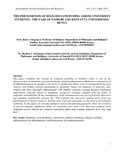| dc.contributor.author | Ongong’a, Jude J | |
| dc.contributor.author | Akaranga:, Stephen I. | |
| dc.date.accessioned | 2015-01-30T13:10:58Z | |
| dc.date.available | 2015-01-30T13:10:58Z | |
| dc.date.issued | 2013 | |
| dc.identifier.citation | Ongong’a Jj, Akaranga Si. "the Phenomenon Of Religious Switching Among University Students: The Case Of Nairobi And Kenyatta Universities, Kenya." International Journal Of Education And Research. 2013;vol.1 (5):241-258. | |
| dc.identifier.uri | http://hdl.handle.net/11295/80124 | |
| dc.description.abstract | This paper examines the concept of religious switching or mobility which is one of the
characteristics of modernity and post
-
mode
rnity religious phenomenon. Modernity is characterized
by differentiations in an attempt to pin down or explain how things work by distinguishing between
essences and finding relevant mechanism of operation. Today, the influence of modernity and,
religion
has been internally differentiated with notable contrasts existing between traditional
authoritative religions based on humanism, prosperity teachings stamped with the marks of
utilitarian individualism. In the contemporary world denominations are less exc
lusivistic than sects
and dominate mainstream religious life. This explains why university students move from one
denomination to another trying to find the same truth and spirituality at the heart of all religious
traditions. In this paper, we ask and att
empt to answer the following questions: Does the existence
of diverse religious affiliations dilute or strengthen ones faith? Are university students more
religiously active? And do new religious experiences affect their original religions? If so, why? an
d
how? | en_US |
| dc.language.iso | en | en_US |
| dc.publisher | University of Nairobi | en_US |
| dc.title | The phenomenon of religious switching among university students: the case of Nairobi and Kenyatta universities, Kenya | en_US |
| dc.type | Article | en_US |
| dc.type.material | en_US | en_US |

